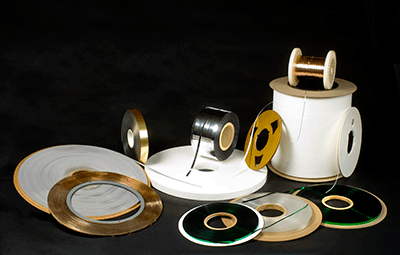In the Spotlight: Metlon Corporation
- Published: September 30, 2019
Precision, Narrow Width Slitting: An Evolving Niche with Ever-Increasing Challenges
By Wayne Etchells, President at Metlon Corporation
Within the converting industry, even the narrow, niche category of precision, narrow width slitting has evolved. Evidence of this has impacted various facets of the business; each is mirrored in every machine, spool and coil Metlon Corporation has re-engineered to meet its customers’ production needs since 1947. Whether for Increased research and development (R&D) across diverse industries, or for increased production capacity, efficiency, accuracy, or cost and/or time saving advantages, client requests and specifications are often more demanding. Often this is in direct response to the customer’s customer, locally or globally. Competition in the shrinking U.S. manufacturing industry drives the need for speed as well as constant re-invention in specialized converting.
Unique materials and specifications. Rigorous standards. Unusually narrow and unusually tight tolerances. These were always our usual jobs. Customers often come as a last resort, claiming this is a “Job that no one else can do.” Or, perhaps, we got the jobs no one else wants to do. Either way, Metlon built its business and reputation on successfully tackling the challenges. And, the goal post keeps moving for clients and for us.

Logically, in responding to his own competitive pressure, the customer pushes his vendors, including the slitter, to produce better and faster. Of course, this is regardless of the material type, quality or specifications provided. Ultimately, the demand for continuous engineering improvement yields better run times, increasing efficiency, productivity and savings for Metlon as well.
One job that exemplifies a combination of performance, cost, waste and production factors is as follows: a customer brought us a 3mil thick polyimide film that was coated on two sides with a dry heat set adhesive. The supply material was 2” wide x 140 meters long and had a value of approximately $2,000 per roll. The customer needed slit widths from 1.0mm up to 2.5mm wide in increments of 0.1mm, and a width tolerance of +/-.025mm (+/-.001”). Prior to coming to Metlon, they were die cutting the material to the finished rectangular shapes that were 1mm and wider by .750” because they were unable to find a company to slit the material to these narrow widths. Die cutting the shapes resulted in a trim loss of 20 percent to 25 percent between the shapes. Melton’s process slit the material onto continuous length reels which reduced its trim loss to less than 5 percent. Success meant significant savings on the expensive material cost in addition to achieving the end product as specified.
As far back as 1995, Metlon Corporation had re-built machinery to rewind on wire spools to help a customer compete with a slit metal coming in from Germany. In this case, a very thin metal slit to 1mm, 1.5mm and 2mm wide that was used in retail theft prevention. In another example, in one case an abrasive film slit to .149” onto a special core that is unusual in the converting industry. After making changes to the take-up equipment, that finished product was shipped to Europe. Today, as Metlon continues to help customers compete globally, this has become the standard.
The materials being slit and the end products made from them are constantly changing. The good news: the range of materials available for new product development or even test runs, is wider. The result is enhanced performance: improved visibility, greater security, longevity, or other measurable metrics. For the custom slitter, that also means adapting slitting and rewinding equipment to maintain current contracts or to compete effectively to secure new customers. The bad news: new products often phase out the old ones. For example, RFID technology improved security in the retail trade, but undermined the need for slitting metals.
Productivity standards have ramped up, either by client demands or vendor capability or both. Greater output is an ongoing goal. In another example, a client that considered a consistent quantity of spools excellent one year more than doubled the required output the following year. Of course, this output required the same consistent quality.
How the converting industry conducts business has impacted not only the manufacturing operation, but also the front office of administration and customer service as well.
For example, confidentiality and non-disclosure agreements were requirements for specialty slitting jobs long before global competition. Today’s need for heightened data as well as patent/product security makes signed agreements and documents the standard. From a marketing standpoint, this has always restricted our ability to write detailed case histories and publish testimonials; likely, others are now obliged to comply.
However, from our earliest years as contract slitters, we adopted the term “partnership” which has acquired vast currency in subsequent years. In advance of an incoming job, Metlon frequently was asked to develop an understanding of the customer’s manufacturing process, whether to prepare our slitting and rewinding equipment and a valid quote, or to actually help with the customer’s production of the material on route to us. Working closely with the customer was part of the process before the practice gained popularity.
All businesses understand that change is a constant. Resilience, together with a reflexive responsiveness to customers, have continued to expand both the capabilities of and competitiveness of Metlon. We acknowledge that our capacity to change probably isn’t infinite. But, the boundaries are not apparent to us or to our customers. Nor are there boundaries to customers’ requests for enhancements of every kind.




